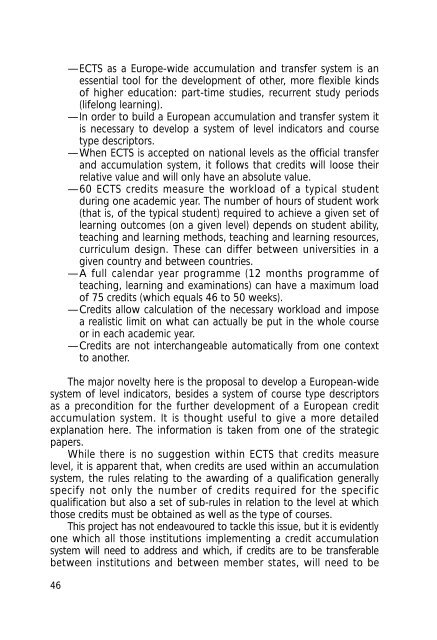Final Report Pilot Project - Relaciones Internacionales de la ...
Final Report Pilot Project - Relaciones Internacionales de la ...
Final Report Pilot Project - Relaciones Internacionales de la ...
Create successful ePaper yourself
Turn your PDF publications into a flip-book with our unique Google optimized e-Paper software.
—ECTS as a Europe-wi<strong>de</strong> accumu<strong>la</strong>tion and transfer system is an<br />
essential tool for the <strong>de</strong>velopment of other, more flexible kinds<br />
of higher education: part-time studies, recurrent study periods<br />
(lifelong learning).<br />
—In or<strong>de</strong>r to build a European accumu<strong>la</strong>tion and transfer system it<br />
is necessary to <strong>de</strong>velop a system of level indicators and course<br />
type <strong>de</strong>scriptors.<br />
—When ECTS is accepted on national levels as the official transfer<br />
and accumu<strong>la</strong>tion system, it follows that credits will loose their<br />
re<strong>la</strong>tive value and will only have an absolute value.<br />
—60 ECTS credits measure the workload of a typical stu<strong>de</strong>nt<br />
during one aca<strong>de</strong>mic year. The number of hours of stu<strong>de</strong>nt work<br />
(that is, of the typical stu<strong>de</strong>nt) required to achieve a given set of<br />
learning outcomes (on a given level) <strong>de</strong>pends on stu<strong>de</strong>nt ability,<br />
teaching and learning methods, teaching and learning resources,<br />
curriculum <strong>de</strong>sign. These can differ between universities in a<br />
given country and between countries.<br />
—A full calendar year programme (12 months programme of<br />
teaching, learning and examinations) can have a maximum load<br />
of 75 credits (which equals 46 to 50 weeks).<br />
—Credits allow calcu<strong>la</strong>tion of the necessary workload and impose<br />
a realistic limit on what can actually be put in the whole course<br />
or in each aca<strong>de</strong>mic year.<br />
—Credits are not interchangeable automatically from one context<br />
to another.<br />
The major novelty here is the proposal to <strong>de</strong>velop a European-wi<strong>de</strong><br />
system of level indicators, besi<strong>de</strong>s a system of course type <strong>de</strong>scriptors<br />
as a precondition for the further <strong>de</strong>velopment of a European credit<br />
accumu<strong>la</strong>tion system. It is thought useful to give a more <strong>de</strong>tailed<br />
exp<strong>la</strong>nation here. The information is taken from one of the strategic<br />
papers.<br />
While there is no suggestion within ECTS that credits measure<br />
level, it is apparent that, when credits are used within an accumu<strong>la</strong>tion<br />
system, the rules re<strong>la</strong>ting to the awarding of a qualification generally<br />
specify not only the number of credits required for the specific<br />
qualification but also a set of sub-rules in re<strong>la</strong>tion to the level at which<br />
those credits must be obtained as well as the type of courses.<br />
This project has not en<strong>de</strong>avoured to tackle this issue, but it is evi<strong>de</strong>ntly<br />
one which all those institutions implementing a credit accumu<strong>la</strong>tion<br />
system will need to address and which, if credits are to be transferable<br />
between institutions and between member states, will need to be<br />
46


